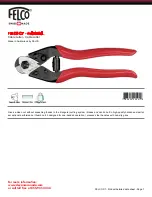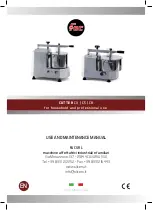
PS-2
Hypertherm Safety and Compliance
Product StewardShiP
English
protection against hazardous moving parts. Unless the higher-
level system is certified when the OEM incorporates Hypertherm
products into it, the installation also may be subject to approval by
local authorities. Seek advice from legal counsel and local regulatory
experts if you are uncertain about compliance.
External interconnecting cables between component parts of the
higher level system must be suitable for contaminants and movement
as required by the final end use installation site. When the external
interconnecting cables are subject to oil, dust, water, or other
contaminants, hard usage ratings may be required.
When external interconnecting cables are subject to continuous
movement, constant flexing ratings may be required. It is the
responsibility of the end-use customer or the OEM to ensure the
cables are suitable for the application. Since there are differences
in the ratings and costs that can be required by local regulations
for higher level systems, it is necessary to verify that any external
interconnecting cables are suitable for the end-use installation site.
Qualification of test personnel
Electrical safety tests for shape cutting equipment can be hazardous
and shall be carried out by an expert in the field of electrical repair,
preferably someone also familiar with welding, cutting, and allied
processes. The safety risks to personnel and equipment, when
unqualified personnel are performing these tests, may be much greater
than the benefit of periodic inspection and testing.
Hypertherm recommends that only visual inspection be performed
unless the electrical safety tests are specifically required by local
national regulations in the country where the equipment is installed.
Residual current devices (RCDs)
In Australia and some other countries, local codes may require the
use of a Residual Current Devices (RCD) when portable electrical
equipment is used in the workplace or at construction sites to protect
operators from electrical faults in the equipment. RCDs are designed
to safely disconnect the mains electrical supply when an imbalance
is detected between the supply and return current (there is a leakage
current to earth). RCDs are available with both fixed and adjustable
trip currents between 6 to 40 milliamperes and a range of trip times
up to 300 milliseconds selected for the equipment installation,
application and intended use. Where RCDs are used, the trip current
and trip time on RCDs should be selected or adjusted high enough
to avoid nuisance tripping during normal operation of the plasma
cutting equipment and low enough in the extremely unlikely event of
an electrical fault in the equipment to disconnect the supply before
the leakage current under a fault condition can pose a life threatening
electrical hazard to operators.
To verify that the RCDs continue to function properly over time, both
the trip current and the trip time should be tested periodically. Portable
electrical equipment and RCDs used in commercial and industrial
areas in Australia and New Zealand are tested to the Australian
standard AS/NZS 3760. When you test the insulation of plasma
cutting equipment to AS/NZS 3760, measure the insulation resistance
according to Appendix B of the standard, at 250 VDC with the power
switch in the ON position to verify proper testing and to avoid the false
failure of the leakage current test. False failures are possible because
the metal oxide varistors (MOVs) and electromagnetic compatibility
(EMC) filters, used to reduce emissions and protect the equipment
from power surges, may conduct up to 10 milliamperes leakage
current to earth under normal conditions.
If you have any questions regarding the application or interpretation
of any IEC standards described here, you are required to consult with
an appropriate legal or other advisor familiar with the International
Electrotechnical standards, and shall not rely on Hypertherm in any
respect regarding the interpretation or application of such standards.
Higher-level systems
When a system integrator adds additional equipment; such as cutting
tables, motor drives, motion controllers or robots; to a Hypertherm
plasma cutting system, the combined system may be considered a
higher-level system. A higher-level system with hazardous moving
parts may constitute industrial machinery or robotic equipment,
in which case the OEM or end-use customer may be subject to
additional regulations and standards than those relevant to the plasma
cutting system as manufactured by Hypertherm.
It is the responsibility of the end-use customer and the OEM to
perform a risk assessment for the higher-level system, and to provide
Summary of Contents for ArcGlide Torch Height Control
Page 1: ...Instruction Manual 806450 Revision 3 November 2010 ArcGlide THC...
Page 2: ......
Page 16: ...English Hypertherm Safety and Compliance S 8...
Page 34: ...1 14 ArcGlide THC Instruction Manual Specifications...
Page 48: ...2 12 ArcGlide THC Instruction Manual INSTALLATION...
Page 100: ...2 64 ArcGlide THC Instruction Manual INSTALLATION...
Page 202: ...6 4 ArcGlide THC Instruction Manual Wiring Diagrams...
Page 207: ......
Page 208: ......
















































